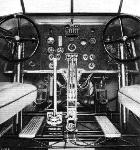
Описание
Страна : Италия
Год : 1930
Tree-engined colonial military transport monoplane
Варианты
- Caproni - Ca.97 - 1927 - Италия
- Caproni - Ca.101 - 1930 - Италия
Caproni Ca 101 и Са 102
Caproni Ca 101, увеличенный в размере Ca 97, появился в 1927 году и вначале строился как гражданский транспортный самолет с тремя звездообразными двигателями Armstrong Siddeley Lynx мощностью по 200 л. с. (149 кВт), построенными по лицензии на заводе фирмы "Alfa Romeo". Позднее Са 101 выпускался как бомбардировщик с тремя звездообразными моторами Piaggio Stella VII мощностью 370 л. с. (276 кВт), им вооружили подразделения ночных бомбардировщиков итальянских ВВС. Самолет принимал участие в кампании, последовавшей после вторжения Италии в Эфиопию 3 октября 1935 года. Итальянская колониальная администрация Восточной Африки использовала Са 101 для решения широкого круга задач, в том числе для ведения разведки и эвакуации раненых. На некоторых самолетах устанавливались звездообразные моторы Walter Castor или Alfa Romeo D2 соответственно мощностью 240 л. с. или 270 л. с. (179 или 201 кВт).
Варианты
Са 102: аналогичен Са 101, но с двумя звездообразными моторами Bristol Jupiter мощностью 500 л.с. (373 кВт). На Са 102quater устанавливались две тандемные пары двигателей
Описание:
- Caproni Ca 101 и Са 102
- Flight, July 1932
CAPRONI 101 "NORD-AFRICA"
Фотографии
-
Мировая Авиация 83
Изображенный Са 101 в начале 1941 года базировался в Папа (Венгрия) и летал в составе З./И Bombazo Osztaly (2-я группа 3-го бомбардировочного полка) Королевских ВВС Венгрии.
-
Aeroplane Monthly 1991-12 / J.Stroud - Wings of Peace
Регистрационный номер: I-ABCB [3] This view of Nord Africa Aviazione’s Ca 101 I-ABCB shows the layout, Jupiter nose engine and outboard Lynx.
-
Aeroplane Monthly 1991-12 / J.Stroud - Wings of Peace
Регистрационный номер: I-AAZA Ca 101 I-AAZA with three 240 h.p. Walter Castor engines.
-
Aviation Historian 32 / M.Wickstead - Italy's forgotten airlines (2)
Регистрационный номер: I-ABCB [3] Caproni Ca.101bis I-ABCB (c/n 3252) was one of six operated by Nord Africa Aviazione (NAA) along the North African coast between Benghazi and Tripoli in Libya. The tri motors entered service with the airline in mid-December 1931, but I-ABCB is listed as having been destroyed in March 1934. The Ca.101 bis was a slightly enlarged variant with more powerful engines for colonial service.
-
Aeroplane Monthly 1991-12 / J.Stroud - Wings of Peace
Регистрационный номер: I-ABCB [3] Ca 101 I-ABCB with NAA’s bird crest on the fin.
-
Aeroplane Monthly 1991-12 / J.Stroud - Wings of Peace
Регистрационный номер: I-ABMA The Caproni C.101 Bomber Monoplane (three 370 h.p. Piaggio "Stella VII" engines).
Piaggio Stella-powered Ca 101 I-ABMA, with mainwheel spats and cowled engines, appears to have been a photographic aeroplane but has been reported as the bomber prototype. -
Авиация и Время 1995-01 / А.Котлобовский - В тени Люфтваффе (Венгерские ВВС на Восточном фронте. Июнь 1942г. - февраль 1943г.) /Аэроархив/ (2)
Транспортный самолет Ca-101 (фото 1941г.)
-
Flight 1936-01 / Flight
OVER ETHIOPIA: Apart from the unpleasant fate which is alleged to await Italian pilots who make forced landings in Abyssinian territory, the terrain suggests that the forced landing itself may be sanguinary enough. The machine - one of the "Disparata" squadron - is a Caproni 101.
-
Flight 1930-05 / Flight
AT MILAN AERO SHOW: The Caproni stand, with the "Ca.101," 12-seater three-engined monoplane and the "100 T" light biplane;
Другие самолёты на фотографии: Caproni Ca.100 Caproncino - Италия - 1929
-
Aviation Historian 32 / M.Wickstead - Italy's forgotten airlines (2)
Aircrew and passengers pose for a photograph beside one of NAA’s six Ca.101s in North Africa. Only 18 civil Ca.101s were built.
-
Flight 1932-07 / Flight
The pilots' cockpit of the Caproni 101 "Nord-Africa.'' The engine control levers and brake lever are seen between the seats.
-
Flight 1932-07 / Flight
Two interior views of the cabin of the Caproni "Nord-Africa." On the left, looking aft, showing at the extreme rear the 2nd Class compartment. On the right, looking forward, showing the wireless installation in forward left-hand corner.
-
Aeroplane Monthly 1991-12 / J.Stroud - Wings of Peace
Регистрационный номер: I-ABCK KEITH WOODCOCK'S painting shows Nord Africa Aviazione’s Caproni Ca 101 Stella Marina.
-
Flight 1932-07 / Flight
Caproni 101 Type "Nord-Africa" One 400 h.p. Bristol "Jupiter", Two 210 h.p. Armstrong Siddeley "Lynx"
- Фотографии















